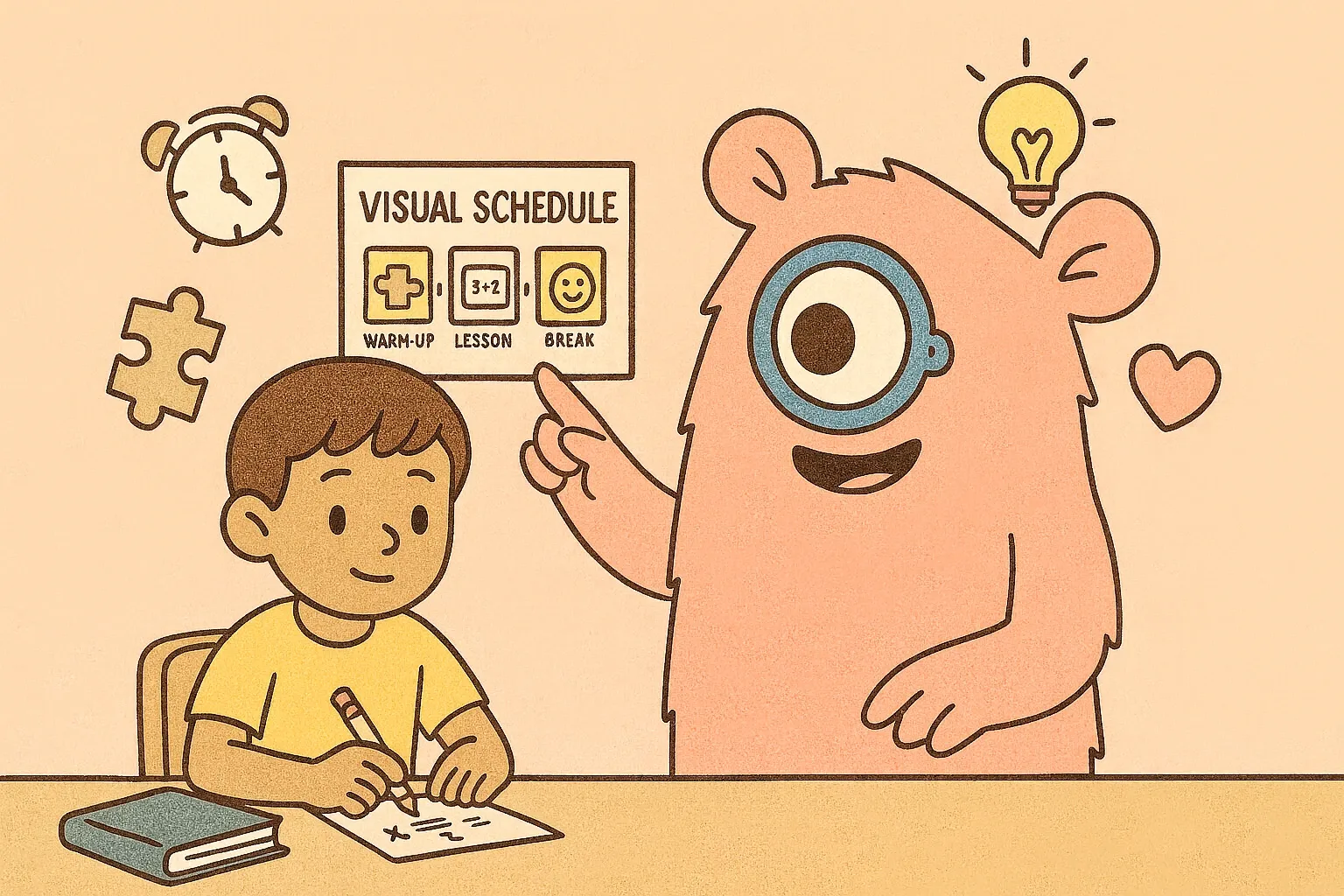10 Classroom Supports That Make Math More Accessible for Autistic Students
TL;DR:Autistic learners do best with clear structure, predictable routines, and low-sensory, low-time-pressure environments. Visual schedules, concrete-to-visual-to-abstract teaching, schema-based instruction for word problems, generous processing time, and options for responding (including AAC) reduce barriers. Add peer supports, interests-based hooks, and self-monitoring checklists and you’ll see steadier focus and more accurate work - without sacrificing rigor.
Many autistic students enjoy math’s logic, but the classroom context - noise, pace, social steps, abstract leaps - can get in the way. In autism, differences in processing speed and time perception mean even capable students may need more time and clearer cues to show what they know, and word problems often hinge on language and executive skills as much as number sense. If anxiety is also in the mix, you’ll find that small, consistent supports lower the load; we walk through practical calming ideas in our guide to math anxiety in autistic kids.
Now, let’s turn those insights into action. Below are ten research-backed classroom supports you can start using today to make math more accessible for autistic students.

1) Make the day predictable with visual schedules and task maps
Start each math block with a written mini-agenda and visual icons for warm-up → lesson → guided practice → break → independent work. Visual activity schedules reliably improve on-task behavior and transitions, and structured-teaching approaches like TEACCH have documented (if small) positive effects across skills. Keep the format consistent so students can anticipate the cognitive load of each segment.
2) Lower sensory load so attention can stick to the math
Seat students away from hums and hallway noise; aim for soft, steady light; offer noise-dampening options and a quiet corner. Classrooms that respect sensory differences see fewer stress behaviors because background noise adds measurable stress for autistic individuals, sensory differences directly affect learning, and lighting and color influence mood and behavior.
For emotional ups and downs during math, you can borrow quick regulation routines from our emotion-regulation strategies.
3) Teach with the Concrete → Representational → Abstract (CRA) sequence
Build new concepts with manipulatives (concrete), draw them (representational), then write symbols (abstract). For autistic learners, CRA pairs well with tech: comparisons of concrete and virtual manipulatives and video-modeled lessons using virtual manipulatives show gains in problem solving, and a single-case study found that video modeling boosted regrouping word-problem performance. As you move off the counters, keep a visual bridge so abstraction doesn’t feel like a cliff.
You can read a more detailed guide on how to use CRA here.
4) Use schema-based instruction to demystify word problems
Teach a few problem “schemas” (e.g., combine, compare, change) with explicit diagrams and cue words, then have students sort problems by type before solving. For autistic students, modified schema-based instruction improves acquisition and maintenance, and a best-evidence synthesis confirms that explicit, schema-based, and technology-assisted approaches are effective. This matters because word-problem success is closely tied to sentence comprehension and math vocabulary, and autistic children show higher rates of problem-solving difficulty even without intellectual disability.
5) Give generous processing time (and reduce time pressure)
Use untimed practice and assessments when possible, add visible timers for work time (not speed races), and normalize “think pauses.” Slower processing speed is a reliable feature of the autistic cognitive profile, as shown in a 2023 meta-analysis, and differences in time perception can make rushed tasks uniquely derailing. A calm pace yields better reasoning and fewer “I knew it but couldn’t show it” moments.
6) Harness special interests to boost motivation and persistence
Wrap practice sets and projects in students’ passions (dinosaurs, transit maps, coding). Interventions that incorporate circumscribed interests increase engagement and learning, and those focused interests also redirect attention in powerful ways. You’ll see more stamina on multi-step work when the context is irresistible.

7) Build peer supports that are structured and safe
Try partner problem-sorting, math talk cards, and roles in small groups (reader, diagrammer, checker). Peer-mediated approaches carry solid evidence: systematic reviews report that peer-mediated interventions improve social skills and that peers can support academic behavior change in cost-effective, generalizable ways. Keep expectations concrete and model the interaction first.
8) Offer multiple response modes - speech, writing, typing, pointing, or AAC
Let students show work by circling, dragging, typing, or speaking; accept diagrams, number lines, and photos of manipulatives. When speech is hard, provide AAC boards or devices during math talk; school-based studies highlight systemic barriers and the need for AAC access, while reviews and field studies describe improved participation with AAC and even peer-mediated AAC gains. The goal isn’t fancy tech - it’s reliable ways to respond.
9) Externalize steps with micro-checklists and worked examples
Print tiny “solve → check units/signs → make sense” boxes next to each problem; keep a worked example visible while students try the next one. Self-management strategies help autistic learners hold focus: recent studies show that self-monitoring of performance reduces disruption and increases task completion, meta-analyses identify self-management as an effective classroom intervention, and classroom tech can make self-monitoring easier to implement.
10) Blend guided practice with brief, brain-friendly breaks
Alternate 8–12 minutes of guided practice with a short stretch or sensory reset, then finish with a quick “show what you know.” This structure respects attention rhythms and leaves space for consolidation; it also pairs well with the visual schedules and CRA steps above. If regulation is the blocker, borrow one or two strategies from our regulation toolkit for math time and teach them proactively.
Conclusion
Accessible math isn’t about lowering expectations - it’s about removing barriers. With predictable routines, sensory-aware classrooms, explicit schemas, generous processing time, and flexible ways to respond, autistic students can show the math thinking they already have. Start with one support, celebrate what works, and keep iterating. The payoff is a calmer room, clearer work, and more confident problem-solvers.
FAQs
- Do autistic students need different math content?
Usually no - the standards stay the same, but the path there is clearer and calmer: CRA sequencing, schema diagrams, and processing time help students apply what they already know. That approach aligns with evidence that explicit and schema-based instruction work well for word problems. - Are timed drills harmful?
They’re often unhelpful. Because many autistic learners show slower processing speed and different time perception, time pressure can mask understanding. Swap speed races for untimed fluency practice and short retrieval bursts. - What if language is the barrier in word problems?
Teach problem types explicitly and front-load vocabulary; success in word problems is tied to sentence comprehension and math vocabulary, and autistic students are more likely to struggle with problem-solving steps without targeted scaffolds. - Is peer work realistic if social interaction is hard?
Yes - with structure. Research on peer-mediated academic support and peer-mediated social interventions shows benefits when roles are clear and routines are practiced. - How do I respond if anxiety spikes mid-lesson?
Use the calm corner, offer a brief break, and restart with a worked example. If math stress shows up often, our math-anxiety guide for autistic learners walks through classroom fixes that reduce triggers.
References
- Knight, V. F., Sartini, E., & Spriggs, A. D. (2015). Evaluating visual activity schedules as evidence-based practice for individuals with autism spectrum disorders. Journal of Autism and Developmental Disorders. Link
- Virués-Ortega, J., et al. (2013). The TEACCH program for children and adults with autism: A meta-analysis. Clinical Psychology Review. Link
- Mallory, C., et al. (2021). Sensory processing and attentional mechanisms: Implications for education in autism. Autism Research. Link
- Jones, E. K., et al. (2020). Sensory processing differences and school participation. Research in Developmental Disabilities. Link
- Nair, A. S., et al. (2022). Effect of light and colors on autistic children in built environments. Journal of Building Engineering. Link
- Root, J. R., et al. (2017). Schema-based instruction with concrete and virtual manipulatives for students with autism. Remedial and Special Education. Link
- Yakubova, G., et al. (2023). Mathematics learning through online video-based instruction using virtual manipulatives. Journal of Autism and Developmental Disorders. Link
- Karal, M. A., et al. (2022). Video modeling for addition word-problems with regrouping in autistic students. Journal of Special Education Technology. Link
- Cox, S. K., et al. (2020). Modified schema-based instruction for autistic students. Education and Training in Autism and Developmental Disabilities. Link
- Root, J. R., et al. (2021). Teaching mathematical word-problem solving to students with ASD: Best-evidence synthesis. Education and Training in Autism and Developmental Disabilities. Link
- Bae, Y. S., et al. (2015). Mathematical word-problem solving in children with ASD: Roles of comprehension and vocabulary. Research in Autism Spectrum Disorders. Link
- Polo-Blanco, I., et al. (2022). Mathematics problem-solving profiles in school-age autistic children. Children. Link
- Zapparrata, N. M., et al. (2023). Slower processing speed in ASD: Meta-analysis. Archives of Clinical Neuropsychology. Link
- Casassus, M., et al. (2019). Time perception and autism: Systematic review. Autism Research. Link
- Haas, A., et al. (2019). Utilizing peers to support academic learning for children with ASD. Journal of Autism and Developmental Disorders. Link
- Chang, Y.-C., et al. (2016). Systematic review of peer-mediated interventions for ASD. Research in Autism Spectrum Disorders. Link
- Dunst, C. J., et al. (2012). Incorporating interests of young children with ASD: Meta-analysis. Topics in Early Childhood Special Education. Link
- Harrop, C., et al. (2018). Circumscribed interests and attention in autism. Autism Research. Link
- Andzik, N. R., et al. (2017). AAC services in schools: Access and outcomes. Augmentative and Alternative Communication. Link
- Bourque, K. S., et al. (2020). Peer-mediated augmentative and alternative communication. Perspectives of the ASHA Special Interest Groups. Link
- Gural, I., et al. (2024). Self-monitoring of performance for students with ASD. Behavior Modification. Link
- Scheibel, G., et al. (2024). Meta-analysis of self-management interventions in ASD classrooms. Research in Developmental Disabilities. Link
- Risse, M. R., et al. (2023). Technology-based self-monitoring in general education. Behavioral Sciences. Link
